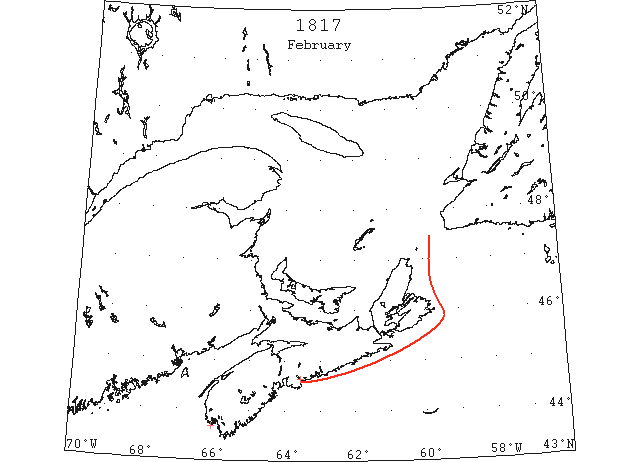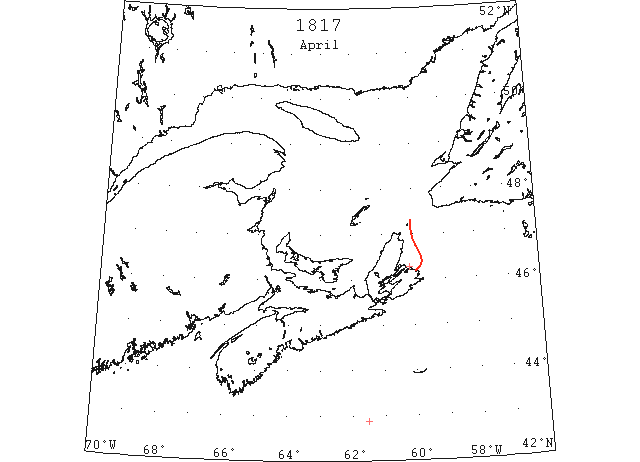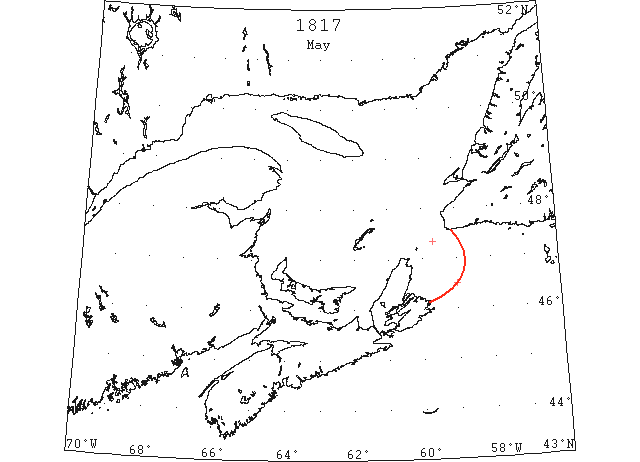1817 Season
Dec It appears the brig “Nerina”, which sailed from this port [Quebec] on the 27th of November was detained by the ice near the Traverse, and ultimately grounded on Goose Island where the passengers were landed with difficulty. The next day, the captain succeeded in getting on board of the brig, and in sending on shore a boat load of baggage, &c., remaining with him the long boat and four men with the intention of landing stores, &c. on the following morning; but in making this attempt, from the intensity of the frost, the boat became fixed in the ice, and they remained in this exposed and perilous situation during five days and four night, and were only kept from perishing by fortunately being well supplied with covering; having been carried a great distance down the river, they were at last happily disengaged from the ice and effected a landing on the south shore, between the east end of Barnaby Island and the west part of Father Point. (QG #3711 02/01/1817 P2 C3c.)
Dec The ship “Latona”, we understand has also been arrested in her progress down the river by the ice. It is said she is secured in a safe winter situation, near St. André, and has received but little injury. (QG #3711 02/01/1817 P2 C3c.)

Feb 1-7 “Our harbour [Halifax] has been so completely blocked up with ice during the past week, that we have not had three arrivals of any description.” (AR 08/02/1817 p2 #6)
Feb 18 “The brig “Hazard”, sch “Perseverance”, of New Brunswick, were frozen up at Tarpolin Cove [Tarpaulin Island?] the 18th ult. (AR 08/03/1817 p3 #5)
Feb 21 A new brig from St. Andrews came to anchor below the Beach in consequence of the harbour [Halifax] being shut in by ice.” (AR 22/02/1817 p3 #3)
Feb 21 By the arrival of some people from Trepassey we are informed that two schooners were driven out of the harbour by ice, and wrecked on the rocks [presumably in Newfoundland and outside area of interest]. (AR 22/03/1817 p2 #6)

Apr 17 Arrived, brig “Elizabeth Campbell” (belonging to Sydney, C.B.) 34 days from Grenada, has been several days to Eastward, but could not get into Sydney on account of the ice. (AR 19/04/1817 p3 #3)
Apr 22 “Fame” [spoken to] 40 days out of St. Andrews had met with a deal of ice and experience much bad weather 42°53’N 61°30’W. (LL)
Apr 23 A letter from Québec of the 23rd ult. [April 23] mentions that the St. Lawrence, as far as ten miles below Québec, continued frozen over. (The Halifax Journal, Vol. VII, No. 42, Monday, May 26, p. [3], col. 3 (bottom)

May 3 Quebec, May 6 [extract from a Tuesday, May 6, Québec City newspaper reprinted in Halifax] On Saturday [May 3] the wind blew strong from the eastward, which had the effect of breaking up the ice before the town, it being on Sunday morning [May 4] in full motion. Another instance of the river St. Lawrence being covered before this town, with fixed ice, on the 3d of May, we believe is not within the memory of the longest liver among us. Maypoles were planted on it on the 1st of the month, and horses, carriages, and horned cattle crossed it to the day of its breaking up. (The Halifax Journal, Vol. VII, No. 47, Monday, June 2, p. [2], col. 4 (middle))
May 14 “The sch “Harrriet”, from thence bound to St. John’s, N.F. put into Sydney on the 14th inst. She left this place on the 26th of April and was prevented by the ice [off NF?]from gaining her destined port.” (AR 31/05/1817 p2 #6)
May (late) ‘A Voyage to the New Land’ from “Hints to Emigrants” in a series of letters from Upper Canada by the Rev. William Bell, 1824 in ‘Great Canadian Adventures’, Reader’s Digest . Ship “Rothiemurchus” departed Leith 5 April. May 16 on the Banks passed 30 masses of ice none of them large except 4. On 21st sighted Newfoundland all covered in snow and very uninviting. Cold intense. The coast of Cape Breton for several miles from the shore was lined with pack ice. Much ice in the entrance to the Gulf.